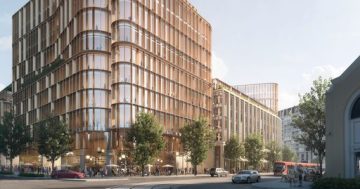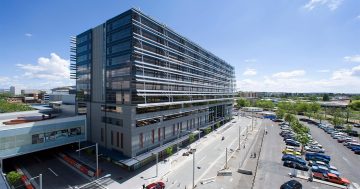
An artist’s impression of one view of the new DEWR, Education building. Photo: Supplied.
On any given day in this ‘post-pandemic’ environment, the Department of Prime Minister and Cabinet will have about 50 per cent of its staff working at their desks.
The same can be said for many federal government departments and agencies right now as working from home remains entrenched across the Australian Public Service.
It all depends on who’s running the agency, of course, with some departmental bosses insisting that all workers come back to the office.
The implications of low occupancy rates inside government buildings these days has even been the subject of Opposition workshopping as the Coalition prepared Senate Estimates questions.
But at a recent hearing of the joint parliamentary standing committee on public works, bureaucrats from the Department of Employment and Workplace Relations (DEWR), the Australian Electoral Commission, and the Department of Education all stressed how a new building to house their staff in Canberra’s CBD was being designed for maximum flexibility – and to attract workers back to the office.
These agencies are setting an example for others with what they hope will be the answer by creating an inviting place for staff to work.
They have plans to move into a new office block on the corner of London Circuit and Northbourne Avenue in 2026.
The signed lease of the 11-storey, 70,000 square metre building, known as the London Quarter, will see the agencies move headquarters from 50 Marcus Clarke Street as well as consolidate working locations that are currently across the ACT and beyond.
Education Department first assistant secretary Scott Wallace told the committee that current working locations were not optimum for staff.
He said the new building will be designed to be more appealing for office-based work.
“Our current utilisation of our existing accommodation footprint runs at around the 50 per cent mark,” he said.
“So on any given day, about 50 per cent of our desks are occupied.
“Clearly, that’s something which reflects an inefficient use of that space and combine that with the lack of collaboration spaces, there are certainly significant opportunities for us to adopt new ways of working.
“We hope to get a much greater occupancy rate in the new building … We believe that there is the capacity for about a 10 per cent growth in our current staffing numbers to be catered for within the building’s combination footprint.”
DEWR will be the main leaseholder, with the other agencies becoming sub-tenants of the new building, which will see the total working floor space reduced by 20,000 square metres.
But DEWR chief operating officer Deborah Jenkins said the home would be a far better situation than the current 11 buildings the departments are using.
“They are very much in the old style of large offices that are not flexible,” Ms Jenkins said.
“So there is quite a waste of space in the current layout; the other thing, in terms of unsuitability, would be the time that we spend running between the buildings … Consolidating into one building creates benefits in how we work, how we connect and also, importantly, creates financial savings for the Commonwealth.”
Savings on lease costs would be about $9 million a year.
“If we use the existing buildings, there would be additional maintenance costs on those buildings too,” Ms Jenkins said.
The Fair Work Commission might also move into the new building.
Workspace is being designed for all of the building’s tenants to attract employees back to the office, with buffer zones and touch-free spaces, as well as designated areas for personal belongings.




















